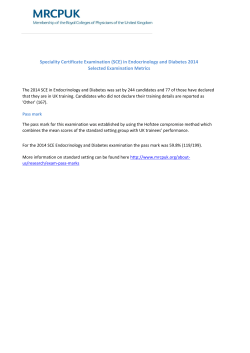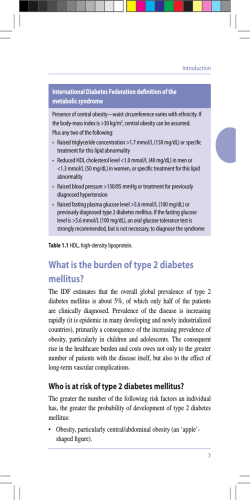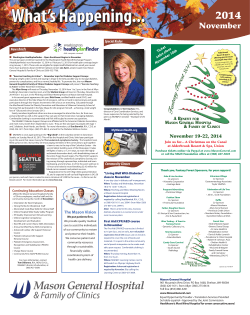
A History of Diabetes Mellitus by Ms. Zobida
A History of Diabetes Mellitus Zobida Ragbirsingh SRN, SCN, DHV, CCDE, MSc. Andrew S. Dhanoo BSc., RPT, PhD (candidate) Chamber of Commerce “Measuring the Impact of Diabetes on Business” Friday 17th April, 2015. What is Diabetes Mellitus ? muscle liver stomach pancreas adiposities blood vessels ‘A group of diseases which affect how the body uses glucose (blood sugar)’ Major types of diabetes mellitus Type 1 DM Type 2 DM - Juvenile onset /IDDM - Adult onset /NIDDM - 5-10 % - 90-95 % - Autoimmune destruction of β-cells - No insulin produced - Abrupt –Early in life - Symptomatic -Exogenous Insulin - Self management - Impaired glucose tolerance (IGT) - Insulin insensitivity / resistance -Risk Factors - Obesity - Poor diet - Sedentary - Smoking - Coloured - Asymptomatic until complications -Lifestyle modification -Oral agents -Insulin -Self management Normal Regulation of Blood Glucose With diabetes High High Low Low Glucose Insulin The whole body is affected by diabetes !!! Micro-vascular Eye: Retinopathy Kidney: Nephropathy Sexual Impotence Macro-vascular Brain: Stoke, Cancer, Dementia Cardiovascular System: Coronary artery disease Periphery: Peripheral Neuropathy, Slow healing, Amputations Risk factors of Type 2 DM Overeating Hereditary Sedentary Old-age Overweight Diabetes Once upon a time, a long time ago… With 3500 years of diabetes history, only the last 100 years saw an explosion of diabetes knowledge and treatment 1500 BC - Egypt First written reference to diabetes by ancient Egyptian physicians 230 BC - Greece Apollonius of Memphis - The name diabetes (from Greek “to pass through”) given to the disease 100 AD - Roman Aulus Cornelius Celsus -First clinical description of diabetes 500 AD - India Susruta and Charaka - First distinction between type 1 and type 2 diabetes mellitus - People with DM has sugary urine 1000 AD - Portugal AvicennsaArab doctor, describes sugar in urine. - Notes gangrene and impotence complications 1696 AD - England Nicholas Culpeper Recommends powered mouse (with Fleas) as treatment for diabetes 1776 AD - England Matthew Dobson-Discovered that Blood and urine of people with DM contains sugar - Concludes that DM is not a disease of the Kidney but the whole body. 1788 AD - England Thomas Cowley-First link between DM and Pancreas 1849 AD - France Claude Bernard -Glucose stored in the Liver - Hypo (low sugar) affects the brain 1869 AD - Germany Paul Langerhans Small clusters of cells in Pancreas, named islets of langerhans 1889 AD - Germany Oscar Minkowski Removed dog’s pancreas – Show DM 1907 AD - Germany Georg ZuelzerPancreatic extract “acomatol,” produced by Zuelzer, decreased glucosuria in dogs 1921 AD - Germany Frederick BantingDiscovery of Insulin Commercial Extracts of Dog pancreas used on humans 1921 AD - Germany SynthalinFirst oral blood sugar lowering medication , extract from French lilac flower 1934 AD - England RD Lawrence and HG Wells First Diabetes Association – British Diabetes Association 1936 AD - Denmark Hans Christian HagedonrnFirst Long Acting Insulin produced 1950 AD Formation of the International Diabetes Federation (IDF) 1955 AD Frederick Sanger- Sequences Insulin ( finds the structure) – Wins Nobel prize 1970 AD Urine testing strips introduced for easy monitoring 1980 AD Portable blood glucose meters become available 1982 AD Diabetes Specialist Nurses (DSN) more common – One of the biggest advancements in diabetes since insulin 1993 AD DCCT – Prove that intense blood sugar control can slow/prevent diabetes complications (type 1) 1998 AD UKPDS – (Type 2)Good control of blood sugar reduces DM complications - Healthy BP reduce Heart attacks and stroke 2003 AD The Human Genome Project – Begin the search for genes linked to DM 2007 AD First Genome-Wide Association Studies for Diabetes – Find genes linking to Type 2 DM Diabetes in the world today Diabetes in the world today World prevalence % By Country (2012- IDF) 223 countries 18 16 14 12 10 8 6 4 2 0 The state of diabetes in Trinidad & Tobago MOH /PAHO – STEPS, 2012 -13% estimated prev. - 20% IGT - ↑ glucose in 16% 15-24 0.15 0.13 0.11 T&T National Health Survey, 1996 -11% self reported diabetics 0.09 0.07 0.05 0.03 0.01 -0.01 Poon-King et al 1968 -2% IGT, 2% T2DM 2 Children <20 presented with T2DM (1962) Poon-King et al. 1968 18:100,000 Children 5-17 with DM and/or IGT (2009) Batson et al. 2013 20.6 % of sample 15-24 years showed ↑ fasting glucose (2012) MOH-PAHO – STEPS 2012 Photo source: UWI Today – Jan 2011 March 31st , 2014 REPORT: ONE IN FIVE CHILDREN IN SOUTH TRINIDAD OVERWEIGHT OR OBESE -Findings highlight need for national surveillance, urgent interventions 3300 Students, 14 Primary Schools, 5-12 years 35 Obese Overweight 70 30 P95 T&T 60 25 CDC P95 50 Weight, kg 20 15 10 40 30 p50 p5 20 5 10 0 0 Boys Girls 1st (4-5yo) 2nd (4-5yo) std 1 (6-7) std 2 (7-8) std 3 (8-9) std 4 (9-10) std 5 (1011) US Cure or Curse ? Non-invasive Screening, Cure Disease, Stop Complications Best known for Carnival, Calypso, Steel band, Reggae, Salsa, Chutney & Meringue -and the most flamboyant and spectacular celebrations in the world DIABETES EDUCATION AWARENESS IN PRIMARY SCHOOLS (DEAPS) DEAPS PROJECTS • A DATT Project • Target Group – Std 3 Students (Primary School) • Objective - Education in a format specifically for the needs of this age group – Increase awareness on prevention mgt of diabetes as it relates to obesity Skits Singing & Dancing TROPHIES BOOKS Other School Supplies Let’s Get Moving! I would like to thank you from the bottom of my pancreas, which is deeper than the bottom of my heart..
© Copyright 2026














